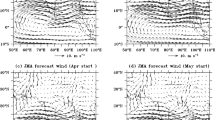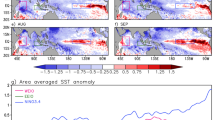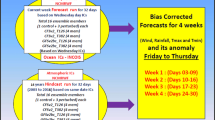Abstract
This study focuses on the short-range prediction of Monsoon Intraseasonal Oscillations (MISOs) using the National Centers for Environmental Prediction(NCEP) Ensemble Prediction System (EPS) data from The Observing System Research and Predictability Experiment (THORPEX) Interactive Grand Global Ensemble (TIGGE) archive. The Indian Summer Monsoon Rainfall (ISMR), which plays an important role in the socio-economic growth of the country, is highly variable and is mostly governed by the MISOs. In addition to this, deterministic forecasts of ISMR are not very reliable. Hence, a probabilistic approach at daily scale is required. Keeping this in mind, the present analysis is done by using daily forecast data for up to 7-day lead time and compared with observations. The analysis shows that the ensemble forecast well captures the variability as compared to observations even up to 7 days. The spatial characteristics and the northward propagation of MISO are observed thoroughly in the EPS. The evolution of dynamical and thermodynamical parameters such as specific humidity, moist static energy, moisture divergence, and vorticity is also captured well but show deviation from the observation from 96 h lead time onwards. The tropospheric temperature forecast captures the observed gradient but with certain bias in magnitude whereas the wind shear is simulated quite well both in pattern and magnitude. These analyses bring out the biases in TIGGE EPS forecast and also point out the possible moist processes which needs to be improved.














































Similar content being viewed by others
References
Abhik S, Halder M, Mukhopadhyay P, et al. (2013) A possible new mechanism for northward propagation of boreal summer intraseasonal oscillations based on TRMM and MERRA reanalysis. Clim Dyn 40:1611–1624. doi:10.1007/s00382-012-1425-x
Abhilash S, AK S, Borah N, et al. (2014) Prediction and monitoring of monsoon intraseasonal oscillations over Indian monsoon region in an ensemble prediction system using CFSv2. Clim Dyn. doi:10.1007/s00382-013-2045-9
Chen S-C, JO R, JC A (1992) Variability and predictability in an empirically forced global model. J Atmos Sci 50:443–463
Chen T-C, Alpert JC (1990) Systematic errors in the annual and intraseasonal variations of the planetary-scale divergent circulation in NMC medium-range forecasts. Mon Weather Rev 118:2607–2623
Duchon CE (1979) Lanczos filtering in one and two dimensions. J Appl Meteorol 18:1016–1023
Gadgil S (2003) The Indian monsoon and its variability. Annu Rev Earth Planet Sci 31:429–467. doi:10.1146/annurev.earth.31.100901.141251
Gadgil S, Gadgil S (2006) The Indian monsoon. GDP and Agriculture:4887–4895
Goswami BB, Mani NJ, Mukhopadhyay P, et al. (2011) Monsoon intraseasonal oscillations as simulated by the superparameterized Community Atmosphere Model. J Geophys Res Atmos 116:n/a–n/a. doi:10.1029/2011JD015948
Goswami BN (2005) South Asian monsoon, chapter 2. In: WKM L, DE W (eds) Intraseasonal variability of the atmosphere ocean climate system, pp. 19–61
Goswami BN, Wu G, Yasunari T (2006) The annual cycle, intraseasonal oscillations, and roadblock to seasonal predictability of the Asian summer monsoon. J Clim 19:5078–5099
Goswami BN, Xavier PK (2005) ENSO control on the south Asian monsoon through the length of the rainy season. Geophys Res Lett 32:L18717. doi:10.1029/2005GL023216
Huffman GJ, Bolvin DT, Nelkin EJ, et al. (2007) The TRMM multisatellite precipitation analysis (TMPA): quasi-global, multiyear, combined-sensor precipitation estimates at fine Scales. J Hydrometeorol 8:38–55. doi:10.1175/JHM560.1
Jiang X, Li T, Wang B (2004) Structures and mechanisms of the northward propagating boreal summer intraseasonal oscillation *. J Clim 17:1022–1039
Jiang X, Waliser DE, Woods C (2011) Vertical cloud structures of the boreal summer intraseasonal variability based on CloudSat observations and ERA-interim reanalysis. Clim Dyn. doi:10.1007/s00382-010-0853-8
Kalnay E, Kanamitsu M, Kistler R, et al. (1996) The NCEP/NCAR 40-Year Reanalysis Project, vol 77, pp. 437–471
Krishnamurti TN, Subramanyam D (1982) The 30–50 day mode at 850mb during MONEX. J Atmos Sci 38(9):2088–2095
Liess S, Waliser DE, Schubert SD (2005) Predictability studies of the intraseasonal oscillation with the ECHAM5 GCM. J Atmos Sci 62:3320–3336
Lorenz EN (1963) Deterministic nonperiodic flow. J Atmos Sci 20:130–141
Pattanaik DR, Kumar A (2009) Prediction of summer monsoon rainfall over India using the NCEP climate forecast system. Clim Dyn 34:557–572. doi:10.1007/s00382-009-0648-y
Reichler T, Roads J-O (2005) Long-range predictability in the tropics. Part II : 30–60-day variability. J Clim 18:634–650
Sahai AK, Sharmila S, Abhilash S, et al. (2013) Simulation and extended range prediction of monsoon intraseasonal oscillations in NCEP CFS/GFS version 2 framework. Curr Sci 104:1394–1048
Sikka DR, Gadgil S (1980) On the maximum cloud zone and the ITCZ over Indian longitudes during the southwest monsoon. Mon Weather Rev 108:1840–1853
Suhas E, Neena JM, Goswami BN (2012) An Indian monsoon intraseasonal oscillations (MISO) index for real time monitoring and forecast verification. Clim Dyn 40:2605–2616. doi:10.1007/s00382-012-1462-5
Taraphdar S, Mukhopadhyay P, Goswami BN (2010) Predictability of Indian summer monsoon weather during active and break phases using a high resolution regional model. Geophys Res Lett 37:n/a–n/a. doi:10.1029/2010GL044969
Waliser D (2012) Predictability and forecasting. In: Lau WKM, Waliser DE (eds) Intraseasonal Var. Atmos. Clim. Syst., second edn. Springer-Praxis, pp 433–476
Waliser DE, Stern W, Schubert S, Lau KM (2003) Dynamic predictability of intraseasonal variability associated with the Asian summer monsoon a) India b) S E Asia. Q J R Meteorol Soc 129:2897–2925. doi:10.1256/qj.02.51
Webster PJ, Magana VO, Palmer TN, et al. (1998) Monsoons : processes, predictability, and the prospects for prediction 2. Description of the monsoons. J Geophys Res 103:14451–144510
Yang S, Zhang Z, Kousky VE, et al. (2008) Simulations and seasonal prediction of the Asian summer monsoon in the NCEP climate forecast system. J Clim 21:3755–3775. doi:10.1175/2008JCLI1961.1
Yasunari T (1979) Cloudiness fluctuations associated with the Northern Hemisphere Summer Monsoon. J Meteorol Soc Japan:227–242
Yasunari T (1981) Structure of an Indian summer monsoon system with around 40-day period. J Meteorol Soc Japan:336–354
Acknowledgments
Indian Institute of Tropical Meteorology, Pune is fully funded by the Ministry of Earth Sciences (MoES), Govt. of India, New Delhi. We would like to thank GIFS TIGGE working group for the TIGGE EPS data. Also, we are thankful to ECMWF for making this data available through their portal and guidance in procurement of data. Prof. B.N. Goswami is thanked for his constant support and encouragement. ST would like to thank Ms. Shilpa Malviya and Mrs. Mercy Varghese for the constructive discussions.
Author information
Authors and Affiliations
Corresponding author
Rights and permissions
About this article
Cite this article
Tirkey, S., Mukhopadhyay, P. Evaluation of NCEP TIGGE short-range forecast for Indian summer monsoon intraseasonal oscillation. Theor Appl Climatol 129, 745–782 (2017). https://doi.org/10.1007/s00704-016-1811-0
Received:
Accepted:
Published:
Issue Date:
DOI: https://doi.org/10.1007/s00704-016-1811-0




